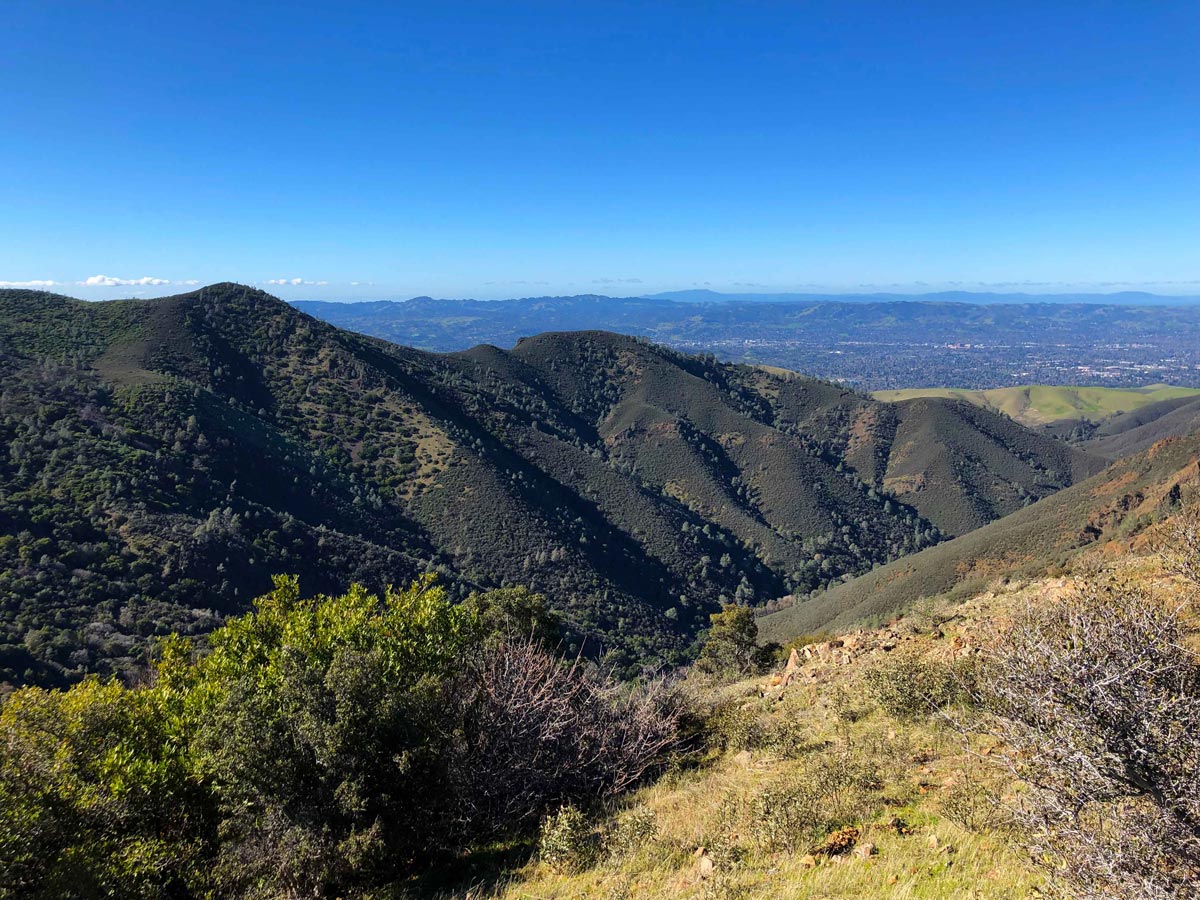As you drive along Route 680 in Contra Costa County, a solitary mountain dominates the horizon. It could almost be mistaken for a volcano. Sacred to the Miwok Indians who once lived here, this geologic show-stopper called Mount Diablo is many things to many people – a wilderness playground, a temple of solitude, a subject for artistic expression. For all who live within its shadow, it’s an everyday reminder of nature’s beauty and endurance.From its 3,849-foot summit – the third highest in the San Francisco Bay Area – are jaw-dropping views that on a clear day encompass up to 80,000 square miles including the San Francisco skyline and Farallon Islands to the west; Mount Hamilton to the southeast; and even the Sierra Nevada and Cascades.
HISTORY
Mount Diablo was born, geologists believe, one to four million years ago from a prehistoric sea, as evidenced by the fossils of ancient marine animals imprinted in rocks quarried from the area.
 The name Mount Diablo did not come along until the much later. According to the Concord Historical Society, it derives from a nickname it was given by Spanish soldiers in the late 1700s – Monte del Diablo. “Monte” described a dense thicket of willows at the north end of the valley that the soldiers believed was possessed by evil spirits, hence the name, “Monte del Diablo” — thicket of the devil. Monte was later misinterpreted by English speakers as “mount” or “mountain”, and the name Mount Diablo stuck.
The name Mount Diablo did not come along until the much later. According to the Concord Historical Society, it derives from a nickname it was given by Spanish soldiers in the late 1700s – Monte del Diablo. “Monte” described a dense thicket of willows at the north end of the valley that the soldiers believed was possessed by evil spirits, hence the name, “Monte del Diablo” — thicket of the devil. Monte was later misinterpreted by English speakers as “mount” or “mountain”, and the name Mount Diablo stuck.
REASONS TO VISIT MOUNT DIABLO
 Mount Diablo became part of the California State Park system in 1921 and has long attracted Bay Area hikers, cyclists, equestrians, and nature lovers. Each year, about 700,000 visitors enjoy its magnificent landmarks and activities. Here are some of our favorites:
Mount Diablo became part of the California State Park system in 1921 and has long attracted Bay Area hikers, cyclists, equestrians, and nature lovers. Each year, about 700,000 visitors enjoy its magnificent landmarks and activities. Here are some of our favorites:
The Mount Diablo Summit & Visitor Center
A trip to Mount Diablo’s summit is a destination in itself. Whether you reach the top by car, foot, or bike, be sure to spend time at the Summit Visitor Center.
Constructed in the late 1930s of sandstone from the park, it boasts engaging exhibits of photos, art, and videos that chronicle the mountain’s history and explain its ecosystem that sustains 400 species of plants and an abundance of wildlife including the once nearly extinct peregrine falcon, grey foxes, coyotes, deer, rabbits, and more.
 Inside the Visitor Center is the actual summit of Mount Diablo, which visitors can walk over on the way to the spacious observation deck. Stunning panoramas await, and telescopes offer close-ups of Northern California landmarks. The famous beacon atop the summit, the “Eye of Mount Diablo”, once aided early transcontinental aviators and is now illuminated every December 7th to honor those who lost their lives at Pearl Harbor.
Inside the Visitor Center is the actual summit of Mount Diablo, which visitors can walk over on the way to the spacious observation deck. Stunning panoramas await, and telescopes offer close-ups of Northern California landmarks. The famous beacon atop the summit, the “Eye of Mount Diablo”, once aided early transcontinental aviators and is now illuminated every December 7th to honor those who lost their lives at Pearl Harbor.
Don’t leave the summit before checking out the Mary Bowerman Loop Trail. Less than a mile long, it starts just below the summit parking area and has comfortable benches to take in the scenic panorama.
Rock City
A Mount Diablo favorite is Rock City. Visitors of all ages will enjoy a playground of natural wonders showcasing the mountain’s evolution. Meander the surrounding trails; explore the sandstone caves; scramble over boulders; and climb Sentinel Rock for one of the park’s most formidable views.
 The Grotto Picnic Area is a relaxing spot for lunch, and a site at the nearby Live Oak Campground can be reserved for overnight fun.
The Grotto Picnic Area is a relaxing spot for lunch, and a site at the nearby Live Oak Campground can be reserved for overnight fun.
Hiking on Mount Diablo
While many of Mount Diablo’s sites are accessible by car, the park is a hiking mecca, with dozens of trails for every level.
The ultimate Mount Diablo experience is to climb from base to summit from the Mitchell Canyon Staging Area in Clayton. Start early; the 13-mile round-trip journey will make for a full but satisfying day.
 Mitchell Canyon is also the starting point for a number of shorter trails, including the 5-mile Donner Creek Loop that will delight winter hikers with waterfalls, as well as the scenic Mitchell Canyon to Eagle Peak 7.4-mile loop.
Mitchell Canyon is also the starting point for a number of shorter trails, including the 5-mile Donner Creek Loop that will delight winter hikers with waterfalls, as well as the scenic Mitchell Canyon to Eagle Peak 7.4-mile loop.
If the summit is calling, but you don’t have the time to start from the base, great options are available mid-range, including the steep 7.6-mile out-and-back hike from Rock City.
For the definitive Mount Diablo experience, the Mountain Loop Trail is a must do. Starting and ending at the Juniper Campground, this connection of trails circumvents the summit along varied, sometimes calf-burning terrain. You’ll discover stunning vistas on every side of the mountain and pass through groves of manzanita, pine, and juniper while birdsong breaks the silence and hawks soar overhead.
 Biking Mount Diablo
Biking Mount Diablo
For cyclists, summiting Mount Diablo is the ultimate conquest, and on most weekends, the paved road to the summit will have as many bikes as cars. The junction where North Gate Road and South Gate Road meet is a popular spot for bicyclists to convene and rest during the rigorous two-dozen mile round-trip ride. Of course, the summit itself, with its welcome facilities and views, is the perfect spot to park it for an extended break.
Off-road bicyclists will also find plenty of challenge on Mount Diablo. Mountain bikes are allowed on paved roads, maintained fire roads, and select trails. A strenuous, 6-mile route that requires some technical skill makes the loop from Juniper Trail to Devil’s Elbow on Summit Road, down North Peak Trail to Prospectors Gap, Meridian Ridge, Deer Flat, and back to Juniper. For a shorter ride with moderate climbs, take Curry Point to Balanced Rock via Knobcone Point fire road.
All bicyclists should have plenty of water and snacks, wear a helmet, and keep a spare tube, patch kit, and trail map handy.
Camping on Mount Diablo
Overnight camping at Mount Diablo is perfect for those who want a star-filled wilderness escape without having to venture far. The park has three designated campgrounds – Juniper, Live Oak, and Junction, plus five group camping areas. Each campground provides a picnic table, fire pit or stove, potable water, and restroom. All except Junction can be reserved up to six months in advance at www.reservecalifornia.com.
PLANNING YOUR VISIT
When to Go
Mount Diablo is open year-round, but season-specific delights add variety to every visit. Wildflowers are at their peak in the spring, and views from the summit are particularly impressive after a winter storm. Wet-season hiking rewards with waterfalls, and while rain and cold won’t threaten a good time in the summer, it can be brutally hot. During the warmer months, hikers should watch for rattlesnakes and scorpions. If creepy crawlers are no bother, check out the tarantula trek that takes place in early fall when the hairy arachnids are mating.
Entrance Areas
If you plan to drive your car into the park, there are two main gates, the South Gate Road entrance on the Danville/Blackhawk side of the mountain, and the North Gate Road entrance on the Concord/Walnut Creek side of the mountain. The $10 entrance fee can be paid with a debit or credit card when the kiosk is staffed.
If you plan to leave your car outside the park, there are two staging areas requiring a $6 cash/check-only parking fee – the Mitchell Canyon Staging Area in Clayton and the Macedo Ranch Staging Area in Alamo.
Visitor Center Hours
The Summit Visitor Center is open 7 days a week from 10am to 4pm. The Mitchell Canyon Visitor Center is open on weekends and some holidays from 8am to 4pm in the summer and 10am to 2pm in the winter.
Dogs
It’s probably best to let Fido sit out your visit to Mount Diablo. Dogs are not allowed on any trails or fire roads. They are allowed, on leash, in developed areas of the park only.



1 comment
Great piece Karen! Love the photo of Mt Diablo!
Comments are closed.